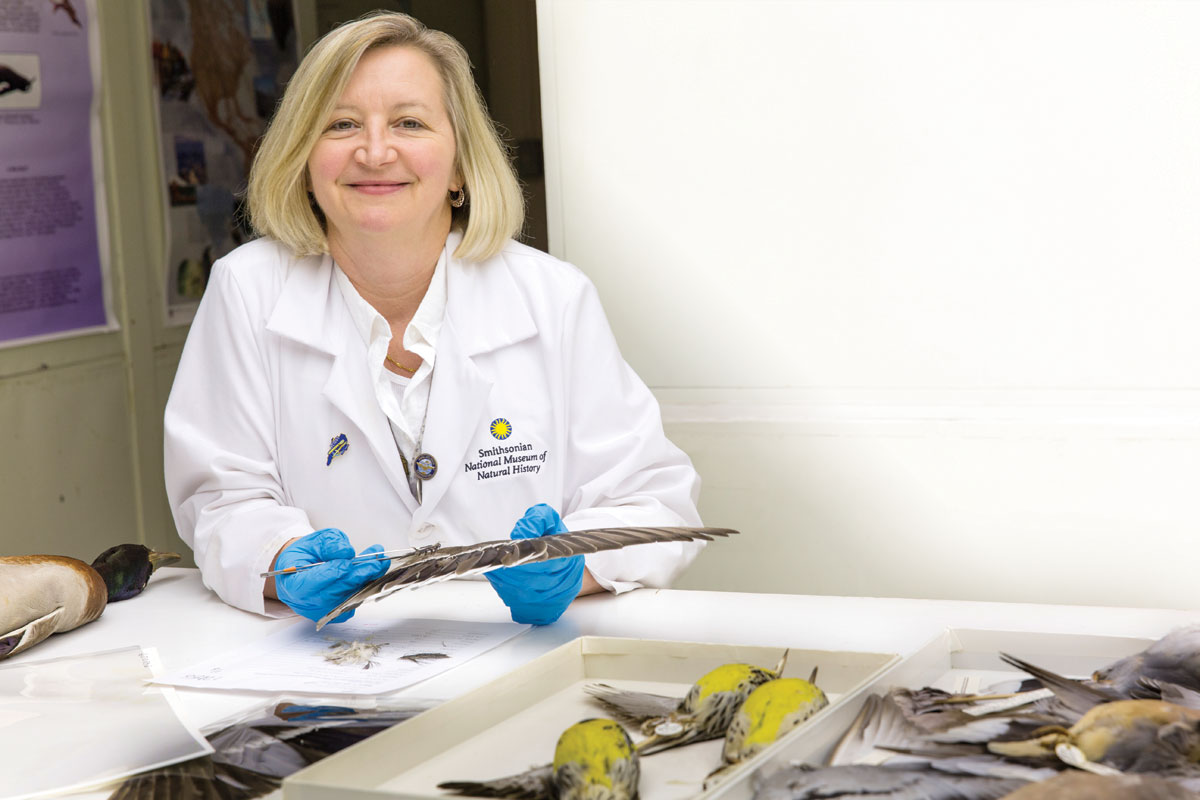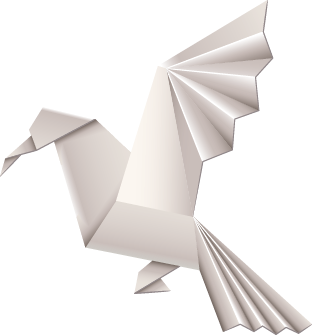- Editorial Offices
- 325 Brantly Hall
- Missoula, MT 59812
- (406) 243-2488
- themontanan@umontana.edu
- Icons By Maria Maldonado
Carla Dove ’86 soars as the nation’s top expert on identifying birds that collide with planes, even when only “snarge” remains

Outside the hallway that leads to Carla Dove’s private office  deep in the Smithsonian National Museum of Natural History in Washington, D.C., a Tyrannosaurus-rex skull, a stone statue from Easter Island, and a wooden totem pole from British Columbia stand guard. In the hallway itself hang thirty-four portraits of distinguished Smithsonian scientists. All of them are men, except one.
deep in the Smithsonian National Museum of Natural History in Washington, D.C., a Tyrannosaurus-rex skull, a stone statue from Easter Island, and a wooden totem pole from British Columbia stand guard. In the hallway itself hang thirty-four portraits of distinguished Smithsonian scientists. All of them are men, except one.
From her desk with the high-powered microscope provided by the Federal Aviation Administration, Dove has carried on the life’s work of that sole woman, her mentor, Roxie C. Laybourne. Today, Dove has succeeded Laybourne’s position as the country’s leading expert in microscopic feather identification, studying bird collisions with airplanes for the sake of making travel safer.
“When you can bring someone here and say, ‘This collection is helping save lives,’” Dove says next to a file cabinet of her microscope slides, “that’s exciting.”
Dove’s expertise vaulted to national attention on January 15, 2009. That afternoon an Airbus A320 jet with 155 passengers hit an unknown bird just after takeoff from New York City’s LaGuardia Airport and crash-landed in the icy Hudson River. Dove examined remains salvaged from two of the plane’s waterlogged engines and identified what species caused the crash—Canada geese, at least four separate ones, from a population based in Labrador.
“The scientific detective work of Dr. Dove and her colleagues was crucial to knowing how many individual birds were involved, what species they were, and whether they were migratory or local,” says Captain Chesley “Sully” Sullenberger, the pilot of that plane who is credited with saving the lives of everyone on board and is now CBS News’ aviation and safety expert.
He adds, “Armed with these data, scientists and aviation experts are working to reduce the risk of aircraft-bird collisions and make air travel safer.”
Dove credits her success in her specialized field to the influence of a series of mentors, culminating with Laybourne. But her pivotal moment, when she decided to dedicate her life to birds and thereby set flight to the events that led to her rise to the Smithsonian, came at the University of Montana.
“That’s the one I consider my home college,” she says.
Dove has hair the color of white corn that hangs past her shoulders, hickory eyes, and a quick smile. She makes easy conversation in a melodious voice clipped with the accent of her native Shenandoah Valley where, in the her small hometown of Fulk’s Run, Va., her father transitioned from serving in the Army to raising chickens on a farm. One of Dove’s earliest memories is revulsion at the thought of one being cut up.
“My grandma would try to get me to butcher chickens,” she says. “Wherever she is she’s probably very proud of me now.”
Dove became the first in her family to go to college when she enrolled at Lord Fairfax Community College in Virginia in 1982. On her way to earning her associate degree in applied science in natural resource management, the young woman with the last name tailor-made for studying birds visited for the first time the citadel of ornithology, the Smithsonian.
“I never thought I’d be working here,” Dove says. “But I thought it was a real cool place.”
Because she grew up loving the outdoors, she enrolled at UM in 1983 and rode in her first airplane to get there.
Excited to see the zoological bounty of her adopted state, she joined a group called the Wildlife Society. On a trip to Yellowstone National Park, she spotted a Harlequin duck colored with lavender, ivory, and orange. She thought it was the most beautiful thing she had ever seen. With her interest in birds piqued, into her life came ornithology Professor Dick Hutto.
He was young and had an infectious passion for birds. A handful of his most dedicated students formed a group that on weekends joined him for outdoor lab work. They traveled to Choteau to see the great biannual migration of snow geese through Freezout Lake, to the Flathead Valley to see great horned owls swoop around the Ninepipe National Wildlife Refuge, to northeast Montana to see sage grouse strut in the Charles M. Russell National Wildlife Refuge, and to the Bitterroot Valley to see a peregrine falcon soar above the Lee Metcalf National Wildlife Refuge. One summer, Dove worked as Hutto’s research assistant for his study on calliope hummingbirds, the smallest bird in the United States.
“It was amazing to me as a young woman, the independence and the freedom—I felt very safe and welcome and encouraged,” Dove says.
Hutto remembers Dove as “enthusiastic” and “gung-ho,” with a curious mind and a good attitude for learning.
“She was the type of student you wanted to have,” he says from his home in Missoula. “That friendly, smiling nature and the interest in the natural world.”
Dove already had started working at the UM Zoological Museum—now the Philip L. Wright Zoological Museum—when Hutto told her something that changed her life. She could make the study of birds a career, he said, even her life’s work.
“I never thought of that before,” she says. “He said it was possible.”
What Dove loved most about the study of birds was the challenge of identifying them based on scant amounts of data—a silhouette of a shape here or a speck of color there.
“It was solving a puzzle,” she says. “That relates directly to what I do now.”
On a Monday in November inside the white-walled, alcohol-scented lab by her office at the Smithsonian, Dove tears open a beige envelope mailed from Utah and pulls out a Ziploc sandwich bag that holds the remains of a bird that collided with a plane—a few crumpled feathers and small lumps of reddish flesh. She calls it “snarge.”
“It means a bunch of ick and stuff,” says the woman who once blanched at butchering chickens. “It’s an odd profession.”
She walks with the snarge into a maze of file cabinets in the museum’s interior that holds 620,000 specimens of birds. Of the more than 10,000 species of birds in the world, around 500 have been involved in collisions with airplanes, and for about 200 species, collisions are commonplace.
From a drawer Dove lifts out a taxidermied killdeer. She combed the feathers on its belly with tweezers until she found one with markings identical to a feather from the Ziploc.
“There’s no other bird that this can be with these feather colors,” she says and looks up. “This is why it’s the best place in the world to do this kind of work.”
 Roxie C. Laybourne pioneered that kind of work. Born the oldest of fifteen children in Fayetteville, N.C., in the early twentieth century, Laybourne worked on aircraft engines in Raleigh while a student at Meredith College, where she also became notorious both as the first woman on campus to wear blue jeans and also for getting disciplined for visiting the local airport to see Amelia Earhart.
Roxie C. Laybourne pioneered that kind of work. Born the oldest of fifteen children in Fayetteville, N.C., in the early twentieth century, Laybourne worked on aircraft engines in Raleigh while a student at Meredith College, where she also became notorious both as the first woman on campus to wear blue jeans and also for getting disciplined for visiting the local airport to see Amelia Earhart.
Laybourne wasn’t allowed to become a pilot herself because she was a woman. She became an expert ornithologist instead with an emphasis on forensics. She helped the FBI catch a killer by matching down from a pillow used to silence a pistol with feather fibers found on the defendant’s pants. She also helped game wardens catch bird poachers.
She rose to prominence inside the Smithsonian in 1960 after a plane crashed and killed sixty-two passengers after taking off from Boston’s Logan Airport. By matching feather fragments from the plane’s engines with specimens from the museum, Laybourne determined that a flock of starlings caused the crash. Her findings led plane manufacturers to build engines better able to withstand bird strikes.
By the early 1980s Laybourne officially retired, though she sped regularly from her home in Manassas, Va., to the Smithsonian in a sporty Datsun 280ZX to teach night classes in bird taxidermy. Dove, who had returned to her home state, initially took a job at a cancer lab after graduating with a degree in wildlife biology from UM in 1986. She enrolled in one of these classes shortly after being hired by the Smithsonian in 1989 simply to learn Laybourne’s bird-skinning methods.
Laybourne saw in Dove an apprentice who could carry on her life’s work.
“I worked with her after hours and on holidays and weekends. I enjoyed it. I had fun,” Dove says. “This is an expertise that takes a lot of training staring through a microscope.”
Laybourne had discovered that each individual fiber in a feather has unique markings. Under microscopes, the fibers show small nodes and spines distinct as fingerprints. Laybourne categorized as many species as she could, but she knew more work needed to be done, especially with new advances in technology. Before she passed away at the age of ninety-two in 2003, Laybourne pushed Dove to first earn a master’s degree from George Mason University in 1994 and then continue through 1998 to earn something Laybourne herself never was able to—a Ph.D.
Dove’s research built on Laybourne’s foundation. She not only catalogued more species of birds by feather fibers, she also began building a database of each bird’s DNA as a complement to—not a replacement for—the art of identifying birds based on snarge. Often DNA becomes corroded by weather, time, or jet fuel, but feather scraps remain. Then the only way to identify the bird is to call the expert, Dove.
“Roxie was a pioneer—she started this,” Dove says. “My contribution is to bring it into the molecular age.”
Both civilian and military airport operators have used Dove’s data to manage bird populations near airports and alter jet paths to reduce collisions with birds.
“Fewer bird strikes means safer flying and a reduction in costly repairs,” said Lieutenant Colonel Michele Boyko, a flight safety officer with the U.S. Air Force. “That means better mission capability.”
Now, with more jets flying around the world than ever, Dove’s workload remains busy and far-flung. Along with the envelope from Utah came a second from Alaska and a third from Djibouti. They were just a few of around 8,000 snarge parcels she receives each year.
One of the most poignant drawers Dove sometimes opens in the Smithsonian archives holds a pair of passenger pigeons, an ivory-billed woodpecker, and a brilliantly colored Carolina parakeet—all extinct. Increasingly, her work is being used to better understand how to stop other species from sharing their fate.
Recently she helped conservation biologists determine the types of rare birds being eaten by studying the stomachs of Burmese pythons that have invaded the Everglades. Park managers used this information to pass laws to try to halt the snakes’ deadly spread. Dove also helped climatologists identify 8,000-year-old feathers unveiled by melting glaciers in the Yukon.
Glacial melt came to her mind when she visited Missoula in the summer of 2015 for the first time since the early 1990s, this time to fly-fish with her husband, Chris Milensky. She was saddened to see mountains she remembered as capped with snow twenty summers ago now ice-free.
But she was glad to reconnect with Hutto, and over dinner at Scotty’s Table she finally expressed her gratitude.
“I said, ‘I want to thank you. You made me realize you can make a living doing something like this, studying birds,’” she says.
Hutto, recently retired from teaching, talked about how much he looked forward to publishing his research papers. One paper, he says, even featured work done by Dove during her time at UM on calliope hummingbirds.
Dove ventured that she recently has thought about making a similar career shift.
The only problem is Dove hasn’t yet found her successor.
“Maybe we’ll get another University of Montana student,” she says.
And maybe when she arrives, the portraits of two women, birds of a feather, will hang in that Smithsonian hallway.